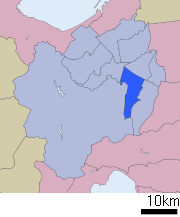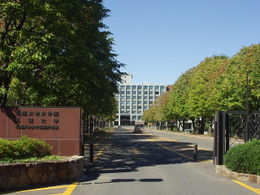
Toyohira-ku, Sapporo
Encyclopedia


Hokkaido
, formerly known as Ezo, Yezo, Yeso, or Yesso, is Japan's second largest island; it is also the largest and northernmost of Japan's 47 prefectural-level subdivisions. The Tsugaru Strait separates Hokkaido from Honshu, although the two islands are connected by the underwater railway Seikan Tunnel...
, Japan
Japan
Japan is an island nation in East Asia. Located in the Pacific Ocean, it lies to the east of the Sea of Japan, China, North Korea, South Korea and Russia, stretching from the Sea of Okhotsk in the north to the East China Sea and Taiwan in the south...
. The ward was established in 1972, when the Sapporo Olympics
1972 Winter Olympics
The 1972 Winter Olympics, officially known as the XI Olympic Winter Games, were a winter multi-sport event which was celebrated from February 3 to February 13, 1972 in Sapporo, Hokkaidō, Japan...
was held in Sapporo. Four other wards in Sapporo are bounded on Toyohira-ku.
Overview

Petunia
Petunia is a widely cultivated genus of flowering plants of South American origin, closely related with tobacco, cape gooseberries, tomatoes, deadly nightshades, potatoes and chili peppers; in the family Solanaceae. The popular flower derived its name from French, which took the word petun, meaning...
. The ward has two mascot characters: Korin is a character whose motif is the apple, which is mainly used to be raised in Toyohira-ku, and Mētan whose motif is the sheep, which is bred in the Hitsujigaoka observation hill
Hitsujigaoka observation hill
is the scenic spot located in Toyohira-ku, Sapporo, Hokkaidō, Japan.The bronze statue of Dr. William S. Clark, which stands on the hill, is well-known as the symbol of frontier spirit of Hokkaidō.- History :...
. Toyohira-ku has some sports venues which were constructed for the Sapporo Olympics
1972 Winter Olympics
The 1972 Winter Olympics, officially known as the XI Olympic Winter Games, were a winter multi-sport event which was celebrated from February 3 to February 13, 1972 in Sapporo, Hokkaidō, Japan...
in 1972, and the Sapporo Dome
Sapporo Dome
The is a stadium located in Toyohira-ku, Sapporo, Japan, and is primarily used for baseball and football. It is the home field of the baseball team Hokkaido Nippon Ham Fighters and the football club Consadole Sapporo.-History:...
is also located.
According to the jūminhyō
Juminhyo
A is a registry of current residential addresses maintained by local governments in Japan. Japanese law requires each citizen to report his or her current address to the local authorities who compile the information for tax, national health insurance and census purposes.The jūminhyō is different...
(registry of current residential addresses and figures) in 2008, 209,358 people are living in Toyohira-ku, which includes 97,999 males and 111,336 females. The total area of the ward is 46.35 km² , and is adjacent to four other wards in Sapporo: Minami-ku
Minami-ku, Sapporo
is one of the 10 wards in Sapporo, Hokkaidō, Japan. Minami-ku is directly translated as "south ward". Having the area of 657.23 km² in total, Minami-ku occupies 60 percent of the area of Sapporo.- Overview :...
, Chūō-ku
Chūō-ku, Sapporo
is one of the ten wards in Sapporo city, Japan. Chūō-ku means "central ward" in Japanese. As its name suggests, city administration and entertainment facilities are centred in this ward.- History :...
, Kiyota-ku
Kiyota-ku, Sapporo
is one of the 10 wards in Sapporo, Hokkaidō, Japan. It is translated as "pure" or "clean" for "清", and " field" for "田". The ward was split from Toyohira-ku on November 4, 1997.- Overview :...
, and Shiroishi-ku
Shiroishi-ku, Sapporo
Shiroishi-ku, Sapporo is one of the ten wards in Sapporo city, Japan....
.
Surrounded by a rich natural environment, Toyohira-ku has a number of rivers including the Toyohira River
Toyohira River
The Toyohira River is a river in Hokkaidō prefecture, Japan. It is 72.5km in length and has drainage area of 959km². It is a tributary of the Ishikari River....
, a tributary of the Ishikari River
Ishikari River
is a river in Hokkaidō, Japan. At in length, the river is the third longest in Japan and the longest in Hokkaidō. The river has a drainage area of , making it the second largest in Japan, as is its total discharge of around per year....
. The Sapporo University
Sapporo University
, also known as 札大 for an abbreviation, is a private university in Sapporo, Japan. It was founded in 1967.-Teaching staff:*Yūtokutaishi Akiyama, artist*Carlo Forlivesi, composer*Tama Morita, writer-Alumni:*Kazuya Kawabata, footballer...
, Hokkai Gakuen University
Hokkai Gakuen University
is a private university in Sapporo, Hokkaidō, Japan. The precursor of the school was founded in 1885, and it was chartered as a university in 1952.- External links :*...
, and Hokkai School of Commerce are located in Toyohira-ku, as well as a number of high schools, junior high schools, elementary schools and nursery schools.
History

Otaru, Hokkaido
is a city and port in Shiribeshi, Hokkaido, Japan, northwest of Sapporo. The city faces the Ishikari Bay, and has long served as the main port of the bay. With its many historical buildings, Otaru is a popular tourist destination...
was laid in the place where Toyohira-ku is currently located. After the Meiji Period
Meiji period
The , also known as the Meiji era, is a Japanese era which extended from September 1868 through July 1912. This period represents the first half of the Empire of Japan.- Meiji Restoration and the emperor :...
, the cultivation in Toyohira-ku was started by pioneers from Honshū, and Hiragishi Village and Tsukisamu Village were formed in 1872, Toyohira Village was established in 1874.
The apple farms were established in Hiragishi Village, which later became famous as the Hiragishi Apple, the IJA 7th Division
7th Division (Imperial Japanese Army)
was an infantry division in the Imperial Japanese Army. Its call-sign was the .-History:The 7th Division was formed in Sapporo, Hokkaidō on 12 May 1888, as the first new infantry division to be created after the reorganization of the Imperial Japanese Army away from six regional commands and into a...
was posted in Tsukisamu Village, and many stores and hotels were erected along the Route 36. Hiragishi and Tsukisamu villages were merged into Toyohira Village in 1902.
In 1908, Toyohira Town was established, and in 1910, Toyohira district in the town was merged into Sapporo district, which was the predecessor of Sapporo City. The entire area of Toyohira Town was merged into Sapporo City in 1961.
In 1972, the Sapporo Olympics
1972 Winter Olympics
The 1972 Winter Olympics, officially known as the XI Olympic Winter Games, were a winter multi-sport event which was celebrated from February 3 to February 13, 1972 in Sapporo, Hokkaidō, Japan...
was held in Sapporo, and as Sapporo was listed as one of the cities designated by government ordinance
City designated by government ordinance (Japan)
A , also known as a or , is a Japanese city that has a population greater than 500,000 and has been designated as such by an order of the cabinet of Japan under Article 252, Section 19 of the Local Autonomy Law.-Overview:...
in the same year, the eastern area of Toyohira Town was split and Toyohira-ku was officially established. In 1997, part of Toyohira-ku was split, and Kiyota-ku
Kiyota-ku, Sapporo
is one of the 10 wards in Sapporo, Hokkaidō, Japan. It is translated as "pure" or "clean" for "清", and " field" for "田". The ward was split from Toyohira-ku on November 4, 1997.- Overview :...
was established.
Points of interest
- Sapporo DomeSapporo DomeThe is a stadium located in Toyohira-ku, Sapporo, Japan, and is primarily used for baseball and football. It is the home field of the baseball team Hokkaido Nippon Ham Fighters and the football club Consadole Sapporo.-History:...
- a stadium which is the home field of the baseball team, Hokkaido Nippon-Ham Fighters, and the football club Consadole SapporoConsadole Sapporois a Japanese professional football club, currently playing in the J. League Division 2. The team is located in Sapporo, on the island of Hokkaidō....
. - Hitsujigaoka observation hillHitsujigaoka observation hillis the scenic spot located in Toyohira-ku, Sapporo, Hokkaidō, Japan.The bronze statue of Dr. William S. Clark, which stands on the hill, is well-known as the symbol of frontier spirit of Hokkaidō.- History :...
- the place where visitors can view the scene of Sapporo City from the hill, also famous for the bronze statue of William S. ClarkWilliam S. ClarkWilliam Smith Clark was a professor of chemistry, botany and zoology, a colonel during the American Civil War, and a leader in agricultural education. Raised and schooled in Easthampton, Massachusetts, Clark spent most of his adult life in Amherst, Massachusetts...
. - Tsukisamu Green DomeTsukisamu Green DomeTsukisamu Green Dome is an indoor sporting arena located in Sapporo, Japan. The capacity of the arena is 5,000. It hosted some of the ice hockey event at the 1972 Winter Olympics.-External links:*...
- one of the events and sports venues in Sapporo. - Hokkaido Prefectural Sports Center (KITAYELL) - an indoor sporting arena.

